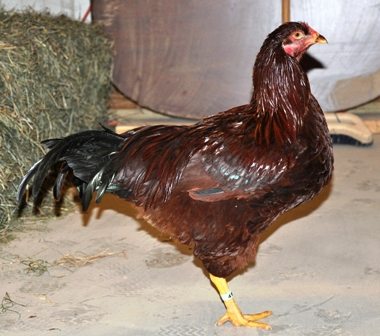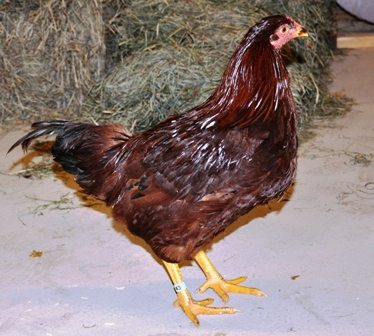
Temperature
For the first five weeks, the chicks were under a red, infrared lamp continuously to keep them warm. But, because fall temperatures swung so drastically, adjusting the lamp to keep the temperature constant was a pain. I checked the temperature (adjusted the lamp) hourly while I was home and awake, which leads to:
- Lesson 1 – They really are pretty resilient, and will moderate the heat themselves by huddling together or spreading apart. You don’t need to check the heat that often – unless you have mother-hen syndrome.
- Lesson 2 – People raise chicks in the spring for a reason – after five weeks we still had to use the lamp at night, whereas if night temperatures were getting warmer (as in springtime), we could have discontinued the lamp altogether much sooner.
Feeding
We’d read that Buckeyes need higher protein feed than other breeds, and most chick starters are relatively low in protein. So, we used a medicated (to protect them from coccidia) turkey starter which contained 30% protein for the first eight weeks. After that, we switched to game bird starter which also contained high protein levels, but wasn’t medicated (so they’d build strong little immune systems).
The feed plan worked well until the store ran out of game bird starter, and we brilliantly tried a high protein, organic feed (we’d used it for the Red Comets successfully). After only a day or two of organic feed, they began picking and eating each other’s feathers (see Feather Picking Chickens); so we quickly found more game bird starter. After just a couple of days back on game bird starter, they quit the feather picking. Turns out, turkey starter, game bird starter, feathers, and cat food all contain animal protein; leading to:
- Lesson 3 – Buckeye chickens want animal protein; dry cat food has animal protein and can be used as an emergency supplement until appropriate feed can be found.
Housing
The chicks were initially raised in an old TV armoire (brooder) placed inside a 10’ x 10’ barn stall; and because of the temperature swings, I thought the garage may have been a better choice. Which brings us to:
- Lesson 4 – Adult chickens are dusty, but growing chickens are unbelievably dusty – I’m so thankful we put them in the barn!
The brooder was opened at five weeks to release them into the stall, and at twelve weeks they started going outdoors during the day. A hawk got one of the boys, so we’re left with 27 Buckeyes (13 boys and 14 girls).
Choosing Keepers
Since we’ll have 19 hens (with the five Red Comet hens already in the coop), we only need two roosters; so 11 of the boys have to go. To help evaluate the boys, we bought the SOP (Standard of Perfection) for poultry and found Selecting for Meat Qualities and Rate of Growth by Jeannette Beranger and Don Schrider free on-line. At eighteen weeks we tried to identify the two keepers, and learned:
- Lesson 5 – The SOP is a nice book, but it’s expensive ($62.00), and we found more useful information in the free article. The SOP has illustrations which aren’t particularly helpful for beginners evaluating a bird.
- Lesson 6 – 18 weeks is quite young to actually choose Buckeye roosters, it’s better to wait until about 24 weeks or longer. So, we ended up just narrowing down to five.
If anyone’s interested, we currently have 8 nice Buckeye cockerels for sale. They’re supposed to be going in the freezer, but I’m having trouble committing.
- Lesson 6 – Don’t allow yourself to become attached to the boys.
Into
At twenty weeks, we decided the five rooster finalists should move into the coop with the five adult Red Comet hens. Since they were male and bigger than the hens, I figured they’d get along well within a few minutes (see Introducing New Chickens). Well, that idea was based on introducing adult roosters, not immature cockerels. Even though the hens were smaller, they bullied and pecked the cockerels terribly.
Lesson 7 – You can mix mature roosters in with hens and they get along quickly; but hens will bully young cockerels when they’re mixed. Watching those big birds being put in their place by the little hens shed new light on the phrase “hen-pecked”.
After a week, the hens calmed down and everyone seems to be getting along. Now, we have to move in the 14 Buckeye pullets. The question is, do they need to be separated in the coop, or will their greater number and familiarity with the cockerels prevent the hens from bullying too much? I feel another lesson coming on…………..
Final Thoughts
Raising day-old Buckeye chicks has been rewarding and enjoyable; and it’s certainly not difficult. The resulting birds are very sociable, inquisitive, and friendly – so I’d definitely recommend the breed, particularly for cold weather areas. They’re out in the cold every day; and it doesn’t seem to faze them. I’m also always amazed at how friendly and inquisitive they are; whenever they see us, they run – toward us!
Having raised two groups of baby birds this year though, I’m really hoping some of the pullets will go broody. I’d be content to let them raise the babies from now on.
Greta says
Thanks again for your informative posts. I’m evaluating chick breeds now and your info just confirmed it: I’ll be getting a few Buckeyes! The others under consideration are Olive Egger; Blue Laced and Silver Laced Wyandotte; and Cuckoo Maran. Any experience with these as far as compatibility?
Thanks!
Linda Ludwig Hull says
I can’t tell if I have two or three roosters or not in my Buckeye brood. I have two that are posturing each other but no one is crowing yet even though they are big.
Sheila McCurley says
How long will you need to feed the Buckeyes a feed with animal protein? I have just received a mixed flock. 2 young Buckeyes ( they still have the white specks on their wing tips, one Speckled Sussex, and 2 arucanas. The Arucanas are the oldest and will be laying within the next 3 weeks. I’m not sure now how to feed them. I have them on Medicated chick starter at the present. I have only had them for 1 week and 3 days.